
Mitchella is a genus of flowering plants in the family Rubiaceae. It is found from China to temperate eastern Asia, and from eastern Canada to Guatemala.

Galium is a large genus of annual and perennial herbaceous plants in the family Rubiaceae, occurring in the temperate zones of both the Northern and Southern Hemispheres. Some species are informally known as bedstraw.
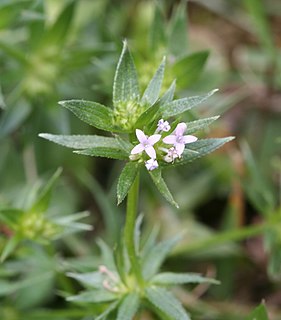
Sherardia is a monotypic genus of flowering plants in the family Rubiaceae. The genus contains only one species, viz. Sherardia arvensis or (blue) field madder, which is widespread across most of Europe and northern Africa as well as southwest and central Asia and Macaronesia. It is also reportedly naturalized in Australia, New Zealand, Taiwan, Kerguelen, Ethiopia, Sudan, southern Africa, Mexico, Costa Rica, South America, Bermuda, Cuba, Haiti and much of Canada and the United States.
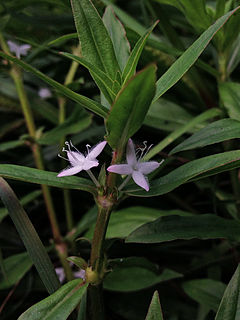
Diodia is a genus of flowering plants in the family Rubiaceae. It was described by Carl Linnaeus in 1753. The genus is found from southern and eastern United States, South America, Central America, Mexico, the West Indies and tropical Africa.

Houstonia (bluet) is a genus of plants in the family Rubiaceae. Many species were formerly classified, along with other genera since segregated elsewhere, in a more inclusive genus Hedyotis.

Spermacoce or false buttonweed is a genus of flowering plants in the family Rubiaceae. It comprises about 275 species found throughout the tropics and subtropics. Its highest diversity is found in the Americas, followed by Africa, Australia and Asia.

Atractocarpus fitzalanii, the brown gardenia or yellow mangosteen, is a species of flowering plant in the family Rubiaceae found in tropical Queensland in Australia. The beautifully scented flowers and lush growth has seen this plant enter cultivation in subtropical gardens in Eastern Australia.
Acrosynanthus is a genus of flowering plants in the family Rubiaceae. It is found in Cuba and Jamaica in the Caribbean.
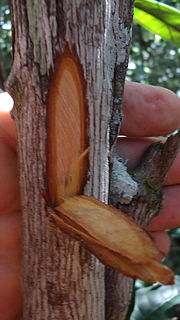
Amaioua is a genus of flowering plants in the family Rubiaceae. It was first described by Jean Baptiste Aublet in 1775. The genus is native to tropical America from southern Mexico to Brazil, including Cuba and Trinidad.
Retiniphyllum is a genus of flowering plants in the family Rubiaceae and contains 20 species. It is the only genus in the tribe Retiniphylleae. The representatives are shrubs or small trees that grow in white sand soils in tropical South America. They are mainly distributed in the Guayana Region (Venezuela) but also occur in the Amazon Basin, the eastern Andes and central and eastern Brasil.

Cubanola is a genus of flowering plants in the family Rubiaceae, with large, showy, hanging flowers. They are endemic to the Dominican Republic and eastern Cuba.
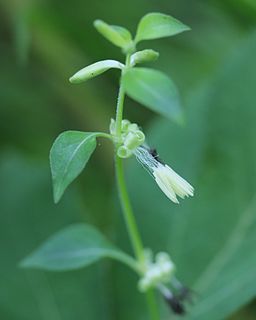
Theligonum is a genus of flowering plants in the family Rubiaceae. It was described by Carl Linnaeus in 1753. The genus is found from Macaronesia to the Mediterranean Basin, and from China to temperate eastern Asia. It is the only genus in the tribe Theligoneae.
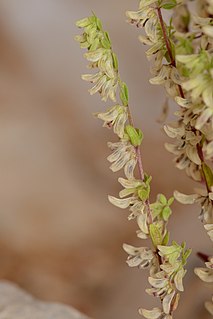
Callipeltis is a genus of flowering plants in the family Rubiaceae. It was originally described in 1829. The genus is found in Spain, North Africa, the Middle East, the Arabian Peninsula, and Central Asia as far east as Pakistan and Kazakhstan.

Galium asprellum, the rough bedstraw, is a plant species in the family Rubiaceae. It native to eastern Canada and northeastern United States, from North Carolina and Tennessee north to Minnesota, Ontario and Newfoundland. It is considered a noxious weed in New York, Pennsylvania and Vermont, and is abundantly common in the other New England states and in sections of the Great Lakes region.

Galium circaezans, common name licorice bedstraw or wild licorice, is a plant species in the family Rubiaceae. It is native to the eastern half of the United States from the Great Plains to the Atlantic, plus Quebec and Ontario. There are also a few isolated populations in Washington state, probably adventive.
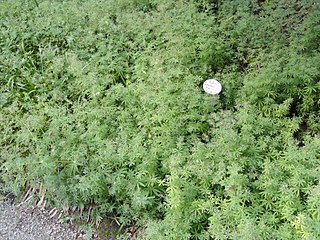
Galium intermedium is a species of plants in the family Rubiaceae. It is native to Central and eastern Europe. It is also reportedly naturalized in Santa Clara County, California.

Galium tinctorium, the stiff marsh bedstraw, is a species of plants in the Rubiaceae. It is widespread and common across the eastern part of North America, from Texas to Labrador and from Minnesota to Florida, plus eastern and central Mexico and the Dominican Republic. It is classed as a noxious weed in some parts of the northeastern United States.
Cremocarpon is a genus of flowering plants in the family Rubiaceae. The genus is found on the Comoros and Madagascar.

Damnacanthus is a genus of flowering plants in the family Rubiaceae. The genus is found from Assam to temperate eastern Asia.
Denscantia is a genus of flowering plants in the family Rubiaceae. The genus is found in eastern Brazil.


















